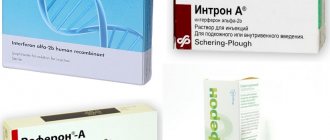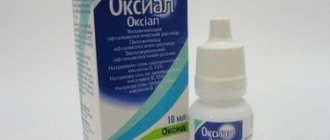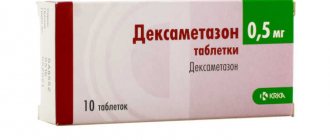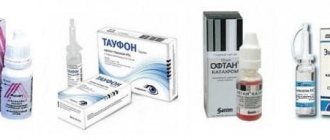Tobrex for children
Tobrex for newborns
Despite the fact that the instructions for the drug indicate insufficient research on the use of Tobrex in children under 1 year of age, the practical experience of pediatricians indicates the high effectiveness of Tobrex in newborns. Another positive thing is that the effect occurs quickly, without requiring long-term treatment.
Tobrex is prescribed to newborns, 1 drop 5 times a day, for no more than 7 days.
If the dosage is followed correctly, complications do not occur. If the doctor's recommendations are not followed, or if the drug is overdosed, the baby may experience hearing impairment, kidney problems, and paralysis of the respiratory muscles. If any abnormalities occur, you should stop treatment with Tobrex and contact your pediatrician or pediatric ophthalmologist.
A child should not use Tobrex on his own without a doctor’s prescription!
How to put eye drops correctly?
Despite the fact that the eye drop procedure is simple, it should be performed according to the rules. The sequence of actions should be like this:
- First you need to wash your hands;
- Shake the bottle with the drug;
- put the baby on his back;
- pull down the lower eyelid;
- turn the bottle upside down;
- apply eye drops without touching the tip to the mucous membrane;
- close your eyes, then lightly massage your eyelid and blot off any excess medication with a napkin.
After use, the bottle should be closed and stored out of reach of the baby. The drug is suitable for use within 30 days after opening.
The procedure for instilling medicine into the eyes is done only with clean hands.
Instructions for use (Method and dosage)
The instructions for Tobrex eye drops and the instructions for Tobrex 2x eye drops differ in the frequency of administration of the drug: the first recommends instilling 1 drop 4-5 times a day, the second advises using 1 drop 2-3 times a day; Tobrex ointment is applied in a 1 cm column 2 times a day.
The difference between Tobrex and Tobrex 2x in the frequency of use is due to the thicker consistency of the latter drug. This feature allows the active substance to remain in the conjunctival sac longer and, therefore, reduce the frequency of drug administration without compromising the therapeutic effect. The course of treatment is 7-10 days.
In special cases, it is possible to practice instillation every hour, however, after the severity of symptoms has subsided, it is necessary to return to the above-mentioned regimen. At night, it is recommended to supplement treatment with Tobrex ointment to prolong contact with the drug.
How safe is the product to use?
The safety of the drug for the baby’s health is a priority issue for parents
When talking about the safety of using an antimicrobial drug in newborns, we should first of all highlight the possibility of a systemic effect on the baby’s body. As noted above, the insignificant concentration of the active substance in Tobrex drops, as well as compliance with the doctor’s recommendations regarding the duration of use of the drug, minimize the entry of tobramycin into the bloodstream.
Parents of babies under one year old should be very attentive to any unusual manifestations that arise during the treatment process. So, you should immediately stop taking the drug and consult a doctor if you notice the following symptoms:
- Individual intolerance to the components of the drug (allergy). Expressed in redness, swelling, burning, itching of the skin and mucous membranes, lacrimation.
- Stinging in the eyes.
- Hyperemia of the eyelids.
- Chemosis is inflammation of the conjunctiva.
- Deterioration of vision (passing).
- The appearance of small ulcers on the cornea.
- Nausea.
- Cramps.
- Disorders of the urinary system.
- Hearing impairment.
Separately, it should be noted that a side effect of long-term use of the drug is superinfection, which appears for several reasons:
- acquisition of resistance by pathogens to a certain type of antibiotic due to unreasonably long treatment;
- immaturity of the immune system of a newborn child;
- addition of a fungal infection.
An overdose of Tobrex drops is extremely rare. Of course, a large dose of an antibiotic will leave a mark on the immune system of any person: be it an adult or a child. However, an overdose of an antibiotic will not cause tangible and immediate consequences.
When prescribing a drug to a newborn, the doctor must take into account its interaction with other medications that the baby is already taking. Thus, due to the tyloxapol contained in Tobrex, it is incompatible with tetracycline drugs.
Among the direct contraindications to the use of the drug indicated in the instructions are confirmed allergies and hypersensitivity to its components.
Signs of bacterial conjunctivitis in children
The main distinguishing symptom of this type of disease is a thick mucopurulent discharge from the eyes, which usually causes eyelashes to stick together, especially after sleep. In addition, conjunctivitis of bacterial etiology also has other symptoms:
- swelling and redness of the conjunctiva;
- photophobia, burning and pain in the eyes;
- dry skin around the organs of vision.
Bacterial conjunctivitis usually occurs in one eye, and within a day or two it affects the other eye. Pyogenic (purulent) infections are also characterized by pain in the organs of vision during an acute course. Some types of disease have their own symptoms. So, with chlamydial conjunctivitis, photophobia occurs - the child experiences discomfort in the eyes in bright light. Vessels on the eyeball may burst, lymph nodes may enlarge, and sometimes hearing may even decrease.
Application
The dosage is prescribed individually depending on the complexity of the inflammation. Typically, this is one drop up to five times during the day in each eye. Before instillation, it is recommended to warm the product in your hands to room temperature.
For uncomplicated eye infections, children are prescribed one drop twice a day.
To relieve acute symptoms, the drug is prescribed for use according to the following scheme: every hour, one drop in each eye. After that, the disease subsides, Tobrex is dripped four times a day. After the acute period has passed, a standard dosage is recommended.
The drug is approved for use from the first days of a child’s life.
Features of using the drug Tobrex:
Eye drops are used only externally and are injected into the area of the conjunctival sac. The basic principles of using the drug tobrex in the form of eye drops are as follows: during the first opening of the bottle, the protective ring should be removed, which serves as a control for the first opening if side effects occur; the use of the drug in children should be stopped; if the child has an allergic reaction to tobramycin, it is not recommended to replace it with drugs based on other aminoglycosides. Most often, children develop a phenomenon such as cross-allergy to all active substances of this group of antibiotics; with prolonged use of Tobrex eye drops, active growth of bacteria that are not sensitive to tobramycin, mainly fungi, is possible. In such cases, the doctor should prescribe appropriate treatment for the child during treatment with Tobrex; the child should stop using contact lenses.
If there is an urgent need to use contact lenses during treatment, then before instilling the drug, the child should remove them and not put them on for 15-20 minutes; in the case of using several eye drops, an interval between administrations of at least 15-20 minutes should be observed after administration of the drug; adult should lightly press down on the child in the area of the lacrimal opening to minimize the penetration of eye drops into the body; it is important to ensure that after administration of the drug the child closes his eyelids slowly
Analogs
If for any reason it is impossible to use Tobrex in a child, the doctor can replace such children's drops with another local antimicrobial medicine, the list of which is quite wide.
- "Floxal". Such drops based on ofloxacin belong to the group of fluoroquinolones and can be used in children with conjunctivitis and other eye infections from birth. The drug is also available in the form of an ointment. Instead of "Floxal" in drops, you can use "Dancil" and "Uniflox" - analogues that also contain ofloxacin.
- "Tsipromed". The effect of these eye drops on pathogenic bacteria is due to ciprofloxacin, which is also a fluoroquinolone. It can be used in children older than one year. "Tsipromed" is also produced in the form of ear drops, which are dripped into the ears of patients over 15 years of age. Analogues of this medicine are drops "Tsiprolet" and "Ciprofloxacin".
- "Torbradex." Unlike Tobrex, such drops contain not only tobramycin, but also dexamethasone. They are prescribed for keratitis, inflammation of the conjunctiva and blepharitis for children over 12 years of age. The drug can be replaced by other combination drugs that act by combining an antibiotic and a glucocorticoid, for example, Sofradex or Maxitrol.
- "Sulfacyl sodium." This medicine from the group of sulfonamides is also called "Albucid". It is used for purulent inflammation of the eyes or for its prevention at any age, including newborns.
- "Vitabact". These eye drops contain picloxidine and can be used for dacryocystitis, keratitis, blepharitis and other eye diseases from birth. Since the active component of Vitabact affects some viruses and fungi, this medicine can also be prescribed for viral conjunctivitis.
- "Levomycetin". This drug contains chloramphenicol and can be used in the form of eye drops at any age. It is prescribed as a drop for blepharitis, barley and other infectious eye diseases.
- "Okomistin". This antiseptic agent acts not only on bacteria, but also on other infectious agents. It contains miramistin and can be used from the age of three. These drops can also be given into the nose or ears.
An ophthalmologist's advice on instilling eye drops in children is presented in the video below.
Tobrex for children
Children over one year old are prescribed Tobrex 1 drop 5 times a day. The course of treatment is no more than 7 days. Indications for treatment are the same as for adults (see above).
Tobrex for newborns
Despite the fact that the instructions for the drug indicate that there has been insufficient research on the use of Tobrex in children under 1 year of age, the practical experience of pediatricians indicates the high effectiveness of Tobrex in newborns. Another positive thing is that the effect occurs quickly, without requiring long-term treatment.
Tobrex is prescribed to newborns, 1 drop 5 times a day, for no more than 7 days.
If the dosage is followed correctly, complications do not occur. If the doctor's recommendations are not followed, or if the drug is overdosed, the baby may experience hearing impairment, kidney problems, and paralysis of the respiratory muscles. If any abnormalities occur, you should stop treatment with Tobrex and contact your pediatrician or pediatric ophthalmologist.
A child should not use Tobrex on his own without a doctor’s prescription!
How to drip Tobrex for children
Before instilling the drug, it is necessary to carry out a hygienic procedure, especially for children who are concerned about eyelid sticking.
To do this, prepare a solution of regular green or black tea, a chamomile decoction, or dissolve a furacillin tablet in half a glass of warm water. Use the resulting liquid to wipe your eyes, remove waste products of microorganisms. Wash your hands before instillation. When instilling, do not touch the tip of the bottle to the mucous membrane of the eye to prevent further spread of the infection.
The frequency of instillation for children under one year of age is 1 drop 5 times a day. Children over 2 years old – 1-2 drops.
Newborns
When using drops for newborns, the drug is instilled 5 times a day, 1 drop. In case of excessive dosage of the medication, it is necessary to rinse the eye with clean, boiled water to remove excess and reduce the likelihood of systemic adverse reactions.
Instructions for use
The instructions for the drug indicate that Tobrex should not be used for more than 7 days. Otherwise, there is a risk of superinfection, which is much more difficult to cure. Superinfection occurs quite often during antibiotic treatment. In different cases, the doctor prescribes a different treatment regimen. How many drops can a baby give?
To treat conjunctivitis, the drug should be instilled 1-2 drops into each eye, slightly moving the lower eyelid. If the inflammatory process is uncomplicated, you need to instill 2 drops into each eye, once every four hours. In the acute phase of the disease, it is recommended to instill eye drops more often - once an hour.
When treating infants, you must strictly adhere to the instructions given by the doctor.
During the treatment of barley, usually the treatment regimen is designed so that the intensity of the effect of the antibiotic gradually decreases. For example, the first two days the eye should be instilled 5 times a day, then 4 times, 3 – and so on until the barley is ripe. However, in each specific case, the doctor may suggest a different treatment plan, depending on the age of the child and the intensity of the inflammatory process.
For dacryocystitis, instillation should be combined with massage. To do this, massage the area from the inner corner of the eye to the wing of the nose with your finger. Make 10 movements up and down, pressing lightly. Massage can be done conveniently during feeding. In some cases, with dacryocystitis, probing of the lacrimal canal is performed (we recommend reading: how to probe the lacrimal canal in children under one year old?).
Use during pregnancy and breastfeeding
There are no or limited data on the topical ophthalmic use of tobramycin in pregnant women. After intravenous administration to pregnant women, tobramycin crosses the placenta and enters the fetal bloodstream. An ototoxic effect of tobramycin is not expected when used during pregnancy.
Tobramycin has been shown in animal studies to have reproductive toxicity only at exposures that are substantially greater than the maximum human exposure of tobramycin, suggesting that these effects are not of significant clinical significance. No teratogenic effect of tobramycin was detected in rats or rabbits.
The use of Tobrex®, eye drops, is not recommended during pregnancy.
It is unknown whether tobramycin is excreted into human milk following topical ophthalmic use. Tobramycin is excreted into human milk after systemic administration.
The detection of tobramycin in breast milk or its ability to cause clinically significant effects in infants of mothers exposed to the drug is unlikely. However, a risk to the infant cannot be excluded.
A decision must be made to discontinue breastfeeding or discontinue/suspension of use of the drug, taking into account the benefits of breastfeeding for the child and therapy for the mother.
Fertility. No studies have been conducted to evaluate the effects of topical ophthalmic tobramycin on human fertility.
Pharmacological properties of the drug:
Tobrex (tobramycin) is a drug that has a rapid bactericidal (kills bacteria) effect on sensitive cells of pathogenic bacteria, mainly on ribosomes. Some bacteria develop so-called resistance to tobramycin during their life, as a result of which Tobrex eye drops for children are ineffective.
There are a number of bacteria that are not susceptible to tobramycin in all cases. Such pathogens of eye diseases are called conditionally resistant. When isolating them in culture from the mucous membrane of a child’s eyes, this fact must be taken into account.
During studies of the drug, a number of bacteria were isolated that were not sensitive to the main component - tobramycin.
In what cases are drops prescribed?
For conjunctivitis
Tobrex drops are suitable for the treatment of conjunctivitis, but only when inflammation occurs due to bacteria, not viruses. The antibiotic is not able to cope with the viral flora, but it is prescribed as part of complex therapy if a bacterial infection is associated with viral conjunctivitis. The drug will not be effective against inflammation caused by allergies.
The causes of the disease in children can be different. For example, in newborns, conjunctivitis most often has a bacterial nature - 60% of babies suffer from the disease in the first month of life. However, only a doctor can determine the factors that provoked the disease.
The instructions indicate that eye drops are used for children not only to treat inflammation, but also to prevent conjunctivitis. The drug helps normalize the functioning of the sebaceous glands and eliminate ulcers.
For dacryocystitis
Tobrex for newborns is often used for dacryocystitis - obstruction of the lacrimal canal, which is complicated by inflammation. The drug shows positive results in the treatment of dacryocystitis, preventing the occurrence of infection. The product can also be used for disinfection after eye surgery, for example, cleaning the tear duct.
For barley
Drops are prescribed for barley - purulent inflammation in the eyelash follicle. Since the formation of pus is caused by bacteria (most often staphylococcus), Tobrex will be effective in treating the disease.
Despite the fact that inflammation with barley is limited, the whole body can react to it. The child experiences general intoxication, body temperature rises, and nearby lymph nodes enlarge. In this case, drops are used in conjunction with systemic antibiotics.
For other eye diseases
The drug is used after injuries and surgery to prevent infection, as well as for:
- inflammation of the cornea;
- endophthalmitis (inflammatory process of the membrane of the eyeball);
- blepharitis (damage to the edge of the eyelid);
- keratoconjunctivitis;
- iridocyclitis.
Only a specialist can diagnose a child; self-medication is excluded. If there is excessive lacrimation, the appearance of pus and swelling, you must make an appointment with an ophthalmologist.
Your doctor may recommend putting eye drops into your nose. This treatment is indicated for bacterial rhinitis, when yellow-green mucus is secreted and body temperature is elevated. The drug kills bacteria, and due to the low concentration of the antibiotic, it is safe for children.
Causes of bacterial conjunctivitis in children
This form of the disease is caused by various pathogenic microorganisms: staphylococci, streptococci, Pseudomonas aeruginosa, etc. They can often become infected by swimming in ponds or pools, or using common hygiene items: towels, soap, and toys. Children's conjunctivitis can develop with diseases of the nasopharynx (sinusitis, rhinitis, tonsillitis). When you sneeze, germs from your nose and throat enter your eyes, causing inflammation. In order to prevent infection with bacterial conjunctivitis, it is recommended to wear protective masks during upper respiratory tract illnesses.
Even a newborn child can get sick with purulent conjunctivitis, having become infected through the mother’s birth canal. Particularly severe pathology in infants is caused by gonococci and chlamydia.
Overdose
In case of an overdose of Tobrex, punctate keratitis of the upper layer of the cornea, skin erythema, excessive lacrimation, and discomfort in the eye area may appear.
Point keratitis is one of the common complications when exposed to large doses of antibiotics. In case of an overdose, small pinpoint defects of the cornea may appear, which will be expressed by additional redness and swelling, and increased irritability of the eye. As a result, vision loss may occur.
Erythema is redness of the eyelid and skin around the eyes. This complication can also occur after an overdose.
This redness is not considered dangerous; it usually disappears within a few hours after the drug stops working.
Erythema is often accompanied by swelling of the lower and upper eyelids and their soreness.
Tearing during overdose occurs frequently, but it also stops if the drug is used at large intervals.
The listed complications are often accompanied by itching, so parents need to make sure that the child does not scratch his eyes and cause an additional infection.
Synonyms of nosological groups
| Category ICD-10 | Synonyms of diseases according to ICD-10 |
| H01.0 Blepharitis | Blepharitis |
| Inflammation of the eyelids | |
| Inflammatory diseases of the eyelids | |
| Demodectic blepharitis | |
| Superficial bacterial eye infection | |
| Superficial eye infection | |
| Squamous blepharitis | |
| H10 Conjunctivitis | Bacterial conjunctivitis |
| Infectious-inflammatory conjunctivitis | |
| Superficial eye infection | |
| Red eye syndrome | |
| Chronic non-infectious conjunctivitis | |
| H10.5 Blepharoconjunctivitis | Blepharoconjunctivitis |
| Staphylococcal blepharoconjunctivitis | |
| Chronic blepharoconjunctivitis | |
| H16 Keratitis | Adenoviral keratitis |
| Bacterial keratitis | |
| Spring keratitis | |
| Deep keratitis without epithelial damage | |
| Deep keratitis without damage to the epithelium | |
| Discoid keratitis | |
| Arborescent keratitis | |
| Keratitis rosacea | |
| Keratitis with corneal destruction | |
| Superficial keratitis | |
| Superficial punctate keratitis | |
| Punctate keratitis | |
| Traumatic keratitis | |
| H16.2 Keratoconjunctivitis | Bacterial keratoconjunctivitis |
| Vernal keratoconjunctivitis | |
| Deep forms of adenoviral keratoconjunctivitis | |
| Infectious conjunctivitis and keratoconjunctivitis caused by Chlamydia trachomatis | |
| Acute allergic keratoconjunctivitis | |
| Phlyctenular keratoconjunctivitis | |
| Chronic allergic keratoconjunctivitis | |
| H20 Iridocyclitis | Sluggish posterior uveitis |
| Indolent posterior uveitis | |
| Posterior uveitis | |
| Iridocyclitis of the posterior segment of the eye | |
| Iridocyclitis and other uveitis | |
| Iritis | |
| Keratoiridocyclitis | |
| Acute iridocyclitis | |
| Acute iritis | |
| Acute non-infectious uveitis | |
| Recurrent iritis | |
| Sympathetic iridocyclitis | |
| Uveitis | |
| Cyclit | |
| H59 Lesions of the eye and its adnexa after medical procedures | Condition after surgery on the eyeball |
| Condition after plastic surgery on the eyelids | |
| Condition after corneal surgery | |
| Condition after eye surgery | |
| Constriction of the pupil after instillation of mydriatics | |
| Z100* CLASS XXII Surgical practice | Abdominal surgery |
| Adenomectomy | |
| Amputation | |
| Angioplasty of coronary arteries | |
| Carotid angioplasty | |
| Antiseptic treatment of skin for wounds | |
| Antiseptic hand treatment | |
| Appendectomy | |
| Atherectomy | |
| Balloon coronary angioplasty | |
| Vaginal hysterectomy | |
| Corona bypass | |
| Interventions on the vagina and cervix | |
| Bladder interventions | |
| Intervention in the oral cavity | |
| Restorative and reconstructive operations | |
| Hand hygiene of medical personnel | |
| Gynecological surgery | |
| Gynecological interventions | |
| Gynecological surgeries | |
| Hypovolemic shock during surgery | |
| Disinfection of purulent wounds | |
| Disinfection of wound edges | |
| Diagnostic interventions | |
| Diagnostic procedures | |
| Diathermocoagulation of the cervix | |
| Long surgical operations | |
| Replacing fistula catheters | |
| Infection during orthopedic surgery | |
| Artificial heart valve | |
| Cystectomy | |
| Short-term outpatient surgery | |
| Short-term operations | |
| Short-term surgical procedures | |
| Cricothyroidotomy | |
| Blood loss during surgery | |
| Bleeding during surgery and in the postoperative period | |
| Culdocentesis | |
| Laser coagulation | |
| Laser coagulation | |
| Laser coagulation of the retina | |
| Laparoscopy | |
| Laparoscopy in gynecology | |
| CSF fistula | |
| Minor gynecological operations | |
| Minor surgical interventions | |
| Mastectomy and subsequent plastic surgery | |
| Mediastinotomy | |
| Microsurgical operations on the ear | |
| Mucogingival surgeries | |
| Stitching | |
| Minor surgeries | |
| Neurosurgical operation | |
| Immobilization of the eyeball in ophthalmic surgery | |
| Orchiectomy | |
| Complications after tooth extraction | |
| Pancreatectomy | |
| Pericardectomy | |
| Rehabilitation period after surgery | |
| The period of convalescence after surgical interventions | |
| Percutaneous transluminal coronary angioplasty | |
| Pleural thoracentesis | |
| Pneumonia postoperative and post-traumatic | |
| Preparing for surgical procedures | |
| Preparing for surgery | |
| Preparing the surgeon's hands before surgery | |
| Preparing the colon for surgery | |
| Postoperative aspiration pneumonia during neurosurgical and thoracic operations | |
| Postoperative nausea | |
| Postoperative bleeding | |
| Postoperative granuloma | |
| Postoperative shock | |
| Early postoperative period | |
| Myocardial revascularization | |
| Resection of the apex of the tooth root | |
| Gastric resection | |
| Bowel resection | |
| Resection of the uterus | |
| Liver resection | |
| Small bowel resection | |
| Resection of part of the stomach | |
| Reocclusion of the operated vessel | |
| Bonding tissue during surgery | |
| Removing stitches | |
| Condition after eye surgery | |
| Condition after surgery | |
| Condition after surgical interventions in the nasal cavity | |
| Condition after gastrectomy | |
| Condition after resection of the small intestine | |
| Condition after tonsillectomy | |
| Condition after removal of the duodenum | |
| Condition after phlebectomy | |
| Vascular surgery | |
| Splenectomy | |
| Sterilization of surgical instruments | |
| Sterilization of surgical instruments | |
| Sternotomy | |
| Dental operations | |
| Dental intervention on periodontal tissues | |
| Strumectomy | |
| Tonsillectomy | |
| Thoracic surgery | |
| Thoracic operations | |
| Total gastrectomy | |
| Transdermal intravascular coronary angioplasty | |
| Transurethral resection | |
| Turbinectomy | |
| Removal of a tooth | |
| Cataract removal | |
| Cyst removal | |
| Tonsil removal | |
| Removal of fibroids | |
| Removal of mobile baby teeth | |
| Removal of polyps | |
| Removing a broken tooth | |
| Removal of the uterine body | |
| Removing stitches | |
| Urethrotomy | |
| CSF duct fistula | |
| Frontoethmoidohaymorotomy | |
| Surgical infection | |
| Surgical treatment of chronic limb ulcers | |
| Surgery | |
| Surgery in the anal area | |
| Colon surgery | |
| Surgical practice | |
| Surgical procedure | |
| Surgical interventions | |
| Surgical interventions on the gastrointestinal tract | |
| Surgical interventions on the urinary tract | |
| Surgical interventions on the urinary system | |
| Surgical interventions on the genitourinary system | |
| Heart surgery | |
| Surgical procedures | |
| Surgical operations | |
| Vein surgery | |
| Surgical intervention | |
| Vascular surgery | |
| Surgical treatment of thrombosis | |
| Surgery | |
| Cholecystectomy | |
| Partial gastrectomy | |
| Transperitoneal hysterectomy | |
| Percutaneous transluminal coronary angioplasty | |
| Percutaneous transluminal angioplasty | |
| Coronary artery bypass surgery | |
| Tooth extirpation | |
| Extirpation of baby teeth | |
| Pulp extirpation | |
| Extracorporeal circulation | |
| Tooth extraction | |
| Tooth extraction | |
| Cataract extraction | |
| Electrocoagulation | |
| Endourological interventions | |
| Episiotomy | |
| Ethmoidotomy |
Contraindications and side effects
Typically, individual intolerance and hypersensitivity are indicated as contraindications. The same principle applies here. But there are a few more points. We must remember that the medicine kills not only pathogenic, harmful, but also beneficial bacteria; against this background, others, for example, fungal diseases, can develop.
In general, the drops are well tolerated. The most common side effects are:
- Redness of the mucous membrane of the eye;
- Itching and burning of the eyelids;
- Swelling of the eyelids or their slight swelling;
- Pain in the eyes and ulcers on the cornea.
The situation is worse if you take this medicine for too long. More than 3-4 weeks. Addiction occurs and microorganisms become insensitive to this antibiotic. A so-called superinfection develops. Her treatment will require much more effort and time.
Please note that if Tobrex is prescribed together with other antibiotics, the side effects from their use may increase. Be sure to tell the doctor if your child has recently taken any other antibiotics for a current illness or another illness.
Recommended reading: how to cure stye under a child’s eye
In case of an overdose, infants may experience hearing complications, including deafness. There may be a malfunction of the kidneys, respiratory paralysis, convulsions. If you notice any changes in the child's appearance or behavior, stop treatment immediately and tell your ophthalmologist or pediatrician. Never use Tobrex on your own! If you follow all the instructions and carefully monitor the dose, there should be no complications.
special instructions
Some patients may experience hypersensitivity to aminoglycosides when administered topically.
Allergic reactions can vary in severity and range from local effects to generalized reactions, including erythema, pruritus, urticaria, rash, anaphylaxis, anaphylactoid reactions or bullous reactions.
If hypersensitivity develops during use of the drug, treatment should be discontinued.
Cross-hypersensitivity to other aminoglycosides may occur, and the possibility should be considered that patients who are hypersensitive to topical tobramycin may also be hypersensitive to other topical and/or systemic aminoglycosides.
Serious adverse reactions, including neurotoxicity, ototoxicity, and nephrotoxicity, may occur in patients receiving systemic tobramycin therapy. Caution should be exercised when co-using tobramycin eye drops and systemic use of aminoglycoside antibiotics.
As with the use of other antibiotics, long-term use of Tobrex® eye drops can lead to excessive growth of non-susceptible microorganisms, incl. mushrooms If superinfection occurs, appropriate therapy must be prescribed.
Wearing contact lenses is not recommended while treating an eye infection.
Tobrex® eye drops contain benzalkonium chloride, which may cause eye irritation and discolor soft contact lenses.
Contact of Tobrex® with soft contact lenses should be avoided. Patients using contact lenses should be informed that before using the drug, they should remove the lenses and put them back no earlier than 15 minutes after instillation of the drug.
Influence on the ability to drive vehicles and machinery. Temporary blurred vision or other vision disturbances after taking this drug may affect your ability to drive or use machinery. If blurred vision occurs after instillation of the drug, then the patient must wait until clear vision is restored before driving a vehicle or operating machinery.
Precautionary measures
Since Tobrex drops are pharmacological agents, when using them it is necessary to follow safety rules and some precautions. It must be remembered that due to exceeding the permissible period of therapy, the medicine can cause the development of superinfection
It is highly undesirable to allow the eye drops in question and contact lenses to come into direct contact. Before instilling the medicine, you need to remove the lenses; They are allowed to be worn only 30 minutes after the procedure.
Important! Only a doctor can provide exact information about how many days Tobrex can be given to a child. You cannot make such decisions on your own, so as not to harm the baby’s health.
Contraindications for use
The drug is not used in case of hypersensitivity or intolerance to some of its components. It is worth remembering that when used, the drug kills both harmful bacteria and natural flora, which can lead to the development of fungal diseases.
Tobrex is prescribed with caution in combination with antibiotics, as it may increase their side effects. If the child is taking or has recently completed treatment with other drugs, it is worth notifying the specialist.
Interaction with other drugs
Tobrex can be prescribed together with any other medications, with the exception of other aminoglycoside antibiotics that are taken orally. If you combine drops with such drugs, side effects may develop, which are called systemic.
If Tobrex is used together with other ophthalmic drugs, they should be injected into the eyes at intervals of 5 minutes. If other eye drops are prescribed along with Tobrex, then the order in which the medications are used is unimportant, and when prescribed along with ointment, Tobrex should be dripped first, and after five minutes the ointment can be added.
Side effects, contraindications
The use of the drug is contraindicated in case of individual intolerance to the components, expressed in the appearance of swelling, increased lacrimation, and redness. Itching and burning may occur, during which the child pulls his hands towards his eyes and rubs them. Possible side effects:
- Allergic reaction;
- Decreased vision (temporarily);
- Inflammation of the mucous membrane;
- Convulsive states;
- Impaired functions of the urinary system;
- Nausea;
- Hearing impairment.
If such signs appear, you must stop using the drug and consult your pediatrician to prescribe another drug and treatment regimen.
Cases of overdose are rare and may cause the occurrence or manifestation of side effects. The drug cannot be prescribed simultaneously with tetracycline antibiotics due to incompatibility of the drugs.
If the duration of treatment is exceeded, an exacerbation of the infection may occur, caused by pathogenic microbes developing resistance to the drug, reduced immunity of the baby, or the occurrence of fungal inflammation that requires treatment with other drugs.
Prevention of bacterial conjunctivitis in children
From an early age, a child should be taught to observe the rules of hygiene in any situation. Explain to him why it is important to wash his hands after returning from the street and before eating, use his own towel, and also not bite his nails and fingers, and do not rub his eyes with dirty hands.
If symptoms of purulent inflammation of the visual organs appear, you do not need to use advice taken from forums on the Internet, but take your child to an ophthalmologist. The signs of different types of eye diseases may be very similar in appearance, but the medications needed to treat them may be different. Only a doctor will determine the cause and prescribe the appropriate medicine. A self-selected remedy can only harm the eyes and delay recovery.
In an advanced stage, bacterial inflammation can take a chronic course and eliminating its symptoms will be much more difficult. In addition, some types of childhood bacterial conjunctivitis can seriously damage the visual organs and lead to vision impairment or loss. Remember, health largely depends only on our attentive attitude towards it.
Compound
The product is an antibiotic with a wide spectrum of action, effective in the fight against Pseudomonas aeruginosa and Escherichia coli, enterococci, Klebsiella, streptococci, enterobacteria and staphylococci. Chlamydia and anaerobic bacteria are resistant to Tobrex drops.
The active component of the drug, tobramycin, has an inhibitory effect on protein synthesis in the cells of pathogenic microbes, leading to their death. Excipients:
- sodium sulfate;
- sodium hydroxide;
- boric acid;
- tilaxopol.
The drug is available in two forms: Tobrex and Tobrex 2x. The second differs in consistency: it is more viscous and allows the medicine to remain in the conjunctival sac longer. The effect of the drug increases, and the frequency of use is reduced to 2 times a day, maintaining the effectiveness of the treatment. It is not used in children under one year of age due to the excipients in the composition that are poorly tolerated by the body of newborns.
The concentration of the active substance is low: 3 mg per 1 ml of the drug. The drops have a local effect, the active substance is excreted through the kidneys unchanged, having minimal effect on the body systems. This allows the product to be used to treat infants from birth. The advantages of Tobrex include high efficiency and absence of mucosal discomfort during instillation.
Release form
Tobrex is available in the form of drops, as well as an ointment - it should be white or cream in color. The ointment is applied to the inner surface of the eyelid in the form of a strip. Due to its thick texture, the drug retains its bactericidal effect longer, however, this form is used mainly for adults. A combination of ointment and drops is possible.
Tobrex drops are produced in plastic dropper bottles with a volume of 5 ml. This amount of solution is quite enough for a course of treatment. The solution is transparent and may have a slightly yellowish tint. In addition to tobramycin, the solution contains excipients: boric acid, sodium sulfate, sodium hydroxide, etc.
Tobrex 2X drops are also on sale. This drug is almost the same in composition as its analogue, but has a thicker consistency. This is due to the presence of xanth gum among the ingredients of the drug. Thanks to this component, the medication stays in the conjunctival sac longer and has time to work more effectively. In this case, the dose of Tobrex 2X drops should be reduced by 2 times compared to regular Tobrex.
Transparent solution from colorless to light yellow.
Eye drops, 0.3%. 5 ml in a Droptainer™ dropper bottle made of LDPE. 1 fl. placed in a cardboard box.
Active ingredient and principle of operation
Tobrex drops are an antibiotic, that is, they inhibit the vital activity of certain types of bacteria. The active ingredient of the drug, Tobramycin, belongs to the group of aminoglycosides. Despite the fact that this antibiotic has a broad spectrum of action, it works most effectively against the following types of bacteria that cause ophthalmic diseases:
- staphylococcus;
- coli;
- streptococcus;
- enterobacter;
- Pseudomonas aeruginosa;
- Klebsiella
Tobramycin may not cope with other types of microorganisms. The instructions indicate that treatment with the drug will not bring results if the disease is caused by anaerobic bacteria or chlamydia. Enterococcus responds to treatment with Tobrex very mediocre.
This local antibiotic is well and completely excreted in the urine without changes. The manufacturer notes that the effect of Tobramycin on the body is negligible. In addition, the dosage of the active substance in the drug is gentle - only 3%. Thanks to the listed properties, Tobrex is indicated for use in children from birth. The doctor must only determine the required duration of treatment.
READ ALSO: How to treat conjunctivitis at home in a 2-year-old child?
Pharmacodynamics
Broad-spectrum antibiotic from the aminoglycoside group. It has a bactericidal effect, disrupting protein synthesis and the permeability of the cytoplasmic membrane of the microbial cell.
– Staphylococci, including S.aureus and S.epidermidis (coagulase-negative and coagulase-positive), including strains resistant to penicillin;
– Streptococci, including some β-hemolytic strains of group A, non-hemolytic species and Streptococcus pneumoniae;
– Pseudomonas aeruginosa, Escherichia coli, Klebsiella pneumoniae, Enterobacter aerogenes, Proteus mirabilis (indole-negative) and indole-positive Proteus species, Haemophilus influenzae and H.aegyptius, Moraxella lacunata, Acinetobacter calcoaceticus (Herellea vaginacola) and some Neisseria species.
Terms of use
The drug must be used in compliance with the following rules:
- wash your hands before and after the procedure;
- if pus has accumulated in the eyes, it must be removed using a turunda soaked in Furacilin solution;
- warm the bottle with the drug in your hands;
- there is a dropper on the container for convenient dosing, but if desired, you can use a pipette;
- pulling down the lower eyelid, you need to drip liquid into the conjunctival sac;
- the dropper or pipette should not touch either the eyelashes or the mucous membrane of the eyes;
- It is necessary to treat both eyes, even if signs of inflammation are visible only in one.
Drop dosage
The exact effect of the drug on newborns is unknown, but experts often prescribe Tobrex to babies. The effect of its use comes quickly, and if the dosage is followed, the therapy will be easy.
Infants with eye disease are usually prescribed drops. For babies under one year of age, 1 drop is instilled 5 times a day. The use of Tobrex 2X is possible only in case of serious pathology.
Unlike newborns, the dose can be increased to 2 drops for older children. When instilling it, you need to make sure that the baby does not rub his eyes with his hands - this can cause an infection.
How often can you drip?
Doses of the drug are prescribed individually for each patient, and the doctor also determines how many days the drug should be infused. During the active phase of the disease, eye drops should be instilled every hour, and if symptoms subside, the interval between applications should be increased to 4 hours. According to the instructions, the drug should be used 5 times a day.
When treating dacryocystitis, you need to massage the tear ducts to cleanse them naturally (we recommend reading: how to massage the tear duct in newborns: video tutorials). For barley, experts recommend pre-rinsing your eyelids with a sponge dipped in tea leaves.
When using Tobrex 2X, the liquid is instilled only 2-3 times a day. This is due to the fact that the substance is viscous and remains in the conjunctival sac longer.
Course duration
The course of antibiotic treatment is 7 days for mild or moderate severity of the disease. If the patient does not show improvement within a week, it is better to change the medicine. Therapy should not be interrupted after 2-3 days, even if the baby’s condition has noticeably improved. This can lead to the re-development of inflammation and the emergence of resistance to the drug in bacteria - you will have to increase the dose of Tobrex or continue treatment with another drug. The duration of therapy will increase significantly.
Reviews from parents
Anna: The child went to kindergarten and the next day he developed a runny nose, fever and conjunctivitis. Tobrex was prescribed. It helped quickly, it didn’t sting when instilled, the baby reacted calmly to the procedure. The disadvantage is the relatively high price compared to domestic Levomycetin and Albucid, short shelf life - 4 weeks.
Alexandra: My newborn son’s eye was swollen, the maternity hospital advised me to choose Tobrex or Sulfacyl sodium. I chose more expensive drops, the effect is good. The swelling and suppuration subsided, the child was not capricious during instillation, and did not notice any redness or other unpleasant side effects.
conclusions
In order to cure an infection of the organs of vision, it is necessary to correctly establish its origin and nature. If its causative agents are pathogenic bacteria, their type should also be determined. Based on these parameters, medications for treatment are selected, including Tobrex. It belongs to those ophthalmic antibiotic medications that have and are capable of destroying many microorganisms of different strains.
Tobrex eye drops for children have proven themselves in the treatment of bacterial eye infections. It affects a large group of pathogenic microorganisms.
This medicine can be used to treat newborns from the first days of life.
In this article we will introduce you to detailed instructions for Tobrex eye drops for children, and provide average prices and reviews from parents. Date: January 8, 2021











